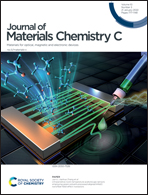Spectroscopic comparison of charge dynamics in fullerene and non-fullerene acceptor-based organic photovoltaic cells†
Abstract
Until recently, the many classes of non-fullerene acceptor (NFA) molecules and polymers exhibited lower power conversion efficiencies than polymer:fullerene counterparts in organic photovoltaic (OPV) cells. We sought to understand the shortcomings of such NFAs, and provide insights for material design in the new era of efficient NFA acceptors. Our study applies broadband transient absorption spectroscopy to a series of donor:acceptor blends, comprising a fixed donor component (PPDT2FBT), and a varying acceptor component of a NFA polymer (N2200), an earlier generation NFA small molecule (NIDCS-HO), or [6,6]-phenyl-C71-butyric acid methyl ester (PCBM) for reference. Our results show that the poor performance of the polymer:polymer blend is explained by incomplete exciton dissociation and rapid geminate recombination. In the case of the small-molecule NFA (NIDCS-HO), we reveal the presence of CT-excitons in the NFA phase, as well as a significant photocurrent generation channel via hole transfer from the NFA. We find that a simple kinetic model of measured charge separation and recombination rates can adequately account for observed photoccurent quantum efficiencies, but the advantage of hole-transfer mediated charge photogeneration (which is less available in fullerene-based devices) may be offset by higher disorder and sub-optimal thin-film morphology for these NFA materials. These results provide valuable insight into how new intrinsic excited states and interfacial excited states need to be accounted for in charge generation dynamics of NFA based OPVs.



 Please wait while we load your content...
Please wait while we load your content...